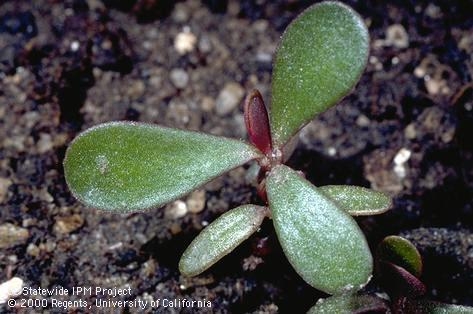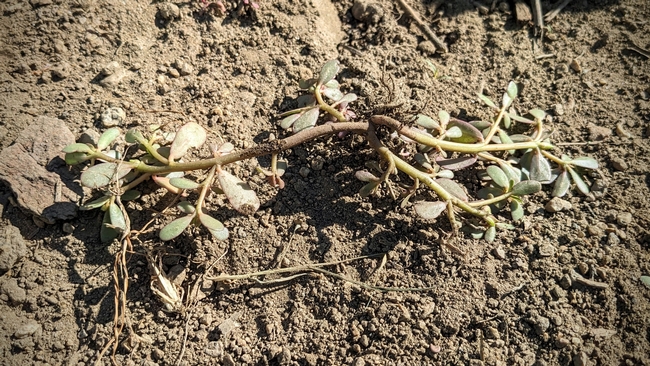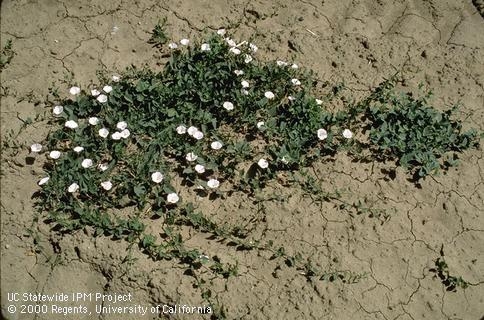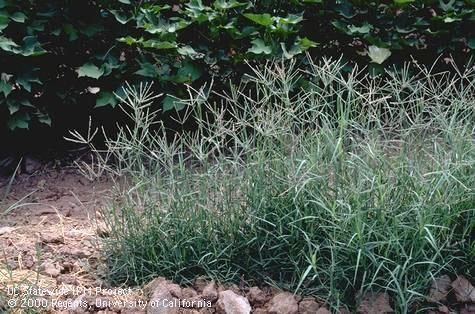I control most of my garden weeds by hoeing and pulling. This morning I was doing a quick once-over with the hoe before work when I was inspired by the abundance of purslane present in the garden to write a quick post on hoeing. Maybe we'll call it Advanced Hoeing? (Done!)
If you've read Alison Collin's previous article on hoes you should be familiar with these tools. I primarily use a hula hoe.*
If you look at how a hula hoe works, it kills weeds by cutting the top of the plant off of its roots. I have very good luck controlling annual grasses, lambsquarters, and Russian thistle. Two weeds that the hoe doesn't work well on are taboose (AKA yellow nutsedge) and purslane.
The lack of control by hoeing taboose makes sense. It has small nutlets that regrow new plants if the top is cut off. I have to dig those out. Taboose control is mostly just a factor of how much effort I want to put into the task. I mostly just live with it, digging a few out when I'm feeling a surge of ambition.
More interesting is the issue with purslane. Purslane is an annual with a fleshy taproot. You would think that hoeing would be very effective in controlling it. But it isn't. If you're not careful, hoeing can just spread it around.
I started this summer with just a little bit of purslane in the garden. Mostly I was fighting grasses, and being my usual lazy self, just hula-hoed up everything and moved on to other tasks. I knew that was probably a bad idea, but: laziness. I ended up spreading purslane all over the place!
Here's the problem: purslane is succulent and easily re-roots. (In fact, you can propagate it that way on purpose!) My hula hoe basically just chopped it up and spread it around. If it's a tiny plant, you may get some control by cultivation or hoeing, but soon thereafter it's no longer effective. All I did was transplant it!
If you're using a hoe, there are some extra steps you need to take with weeds like this that can both tolerate drought stress and have the potential to grow new roots.
First, make sure that the surface of the ground is going to be dry during the heat of the day. Adjust your watering schedule if needed. Next, when you hoe (or pull) purslane, make sure the whole plant ends up upside-down. It will not root easily if it is inverted, and the dry, hot conditions will hopefully kill it quickly. If you really want to be sure you're not going to spread it around, you should rake it out after hoeing. That's good advice for any weeds. Lazy me just leaves it if it's not too giant.
There are two other common weeds that you should also handle differently when hoeing. Field bindweed and bermudagrass tend to spread if chopped up and spread around. These need to be either dug out thoroughly and removed or controlled using other methods. See the pictures below to learn to identify these.
You are better off not jumping in and hoeing these two baddies since they are easy to spread. Consult UC IPM for control advice first.
If you have more questions on controlling weeds in the garden, or you're just a hoeing enthusiast who would like to swap stories with like-minded individuals, contact our Master Gardener helpline at immg@ucanr.edu.
_____
* It's probably better to call it something generic like a stirrup or scuffle hoe, but those neural connections fused in my brain decades ago, so I'm calling it a hula hoe. Whatever you call it, it's a great garden tool.



